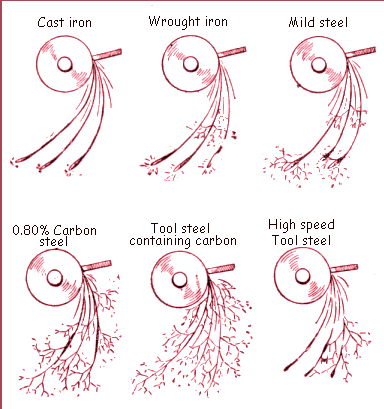
There are many different kinds and grades of iron and steel used in implements and other farm equipment. To be better enabled to repair such equipment, one should know something about the different kinds of iron and steel and their properties and uses.
Pig Iron
The first step in the manufacture of iron and steel is to extract the iron from the iron ore, which is mined in various parts of the world. This is done by means of the modern blast furnace. The molten iron accumulates at the bottom of the furnace and is drawn off into sand molds and allowed to cool and form short, thick bars known as pig iron. Pig iron is then used as the source from which other kinds of iron andsteel are made.
Wrought Iron
Wrought iron is practically pure iron with only very small amounts of carbon or impurities. It is made by removing the carbon and impurities from pig iron. The best grade of wrought iron comes from Norway and Sweden where the purest iron ores are mined. Wrought iron was formerly used extensively by blacksmiths. but because of its high price, its use at present is quite limited. Wrought iron has about 0.04 per cent carbon.
Cast Iron
To make castings, the pig iron is remelted, together with small amounts of scrap iron, and poured into molds of the desired shape and then allowed to solidify. Cast iron is used extensively because it is cheap and can be readily molded into complicated shapes. It is hard and brittle and cannot be bent. It cannot be forged or welded in the forge fire, but it can be welded with the oxyacetylene torch. It crumbles when it is heated to a bright red or white heat. It can be drilled and sawed easily and also filed easily after the hard outer shell is removed. The quality of cast iron can be controlled by varying the amounts of scrap iron and steel mixed with pig iron when it is melted.
Chilled Iron
Chilled iron is cast iron that has been made in special molds, sometimes water-cooled molds, that cool the outer portions of the casting rapidly, thus making the surface of the casting very hard and wear resistant. Chilled iron is used for bearings on certain farm machines and for shares and mold boards of plows that are to be used in gravelly or stony soils.
Malleable Iron
Malleable iron is cast iron of special composition that has been treated, after casting, by heating for a long period. This prolonged heating removes some of the carbon from the surface of the casting and reduces its brittleness. Malleable castings are softer and tougher than plain castings and can be bent a certain amount without breaking. They are also more shock resistant.
Mild Steel
Mild steel, also known variously as machine steel, low-carbon steel, soft steel, and blacksmith iron, is the common material used by blacksmiths. It is made by removing practically, but notq uite, all the carbon from pig iron. To remove it all would be much more expensive. It contains from about 0.1 to 0.3 per cent carbon, not enough to enable it to be hardened to any appreciable extent by heating and quenching in water. It can be bent and hammered cold to some extent and can be forged and welded in the forge. It is a little more difficult to weld than wrought iron.
Tool Steel
Tool steel is made from pig iron by first removing all the carbon and practically all the impurities and then adding a definite, known amount of carbon. Tool steel contains from about 0.5 to about 1.5 per cent carbon. It is granular in structure instead of fibrous or stringy. It must not be heated higher than a bright-red or low-orange heat, or it will become honeycombed and therefore weak and brittle. The higher the percentage of carbon the harder the steel may be tempered, an the more difficult it is to weld. Blacksmiths' tools, such as hammers and cold chisels, are commonly made of steel having from 0.5 to 0.9 per cent carbon.Taps and dies and such tools are made of steel having 1 to 1.25 per cent carbon.
The carbon content of iron and steel is designated by points, one point being one-hundredth of 1 percent of carbon. Thus a 50-point carbon steel contains 50/100 or one-half of 1 per cent of carbon.
Distinguishing between Grades of Steel. A good way to distinguish between the various grades of steel is to grind them on a grinding wheel and note the sparks that are given off. Sparks from wrought iron are light yellow or red and follow straight lines. Sparks from mild steel are similar but more explosive or sprangled. Tool steel gives off sparks that are lighter in color and still more explosive. The higher the percentage of carbon in steel the brighter and more explosive are the sparks.